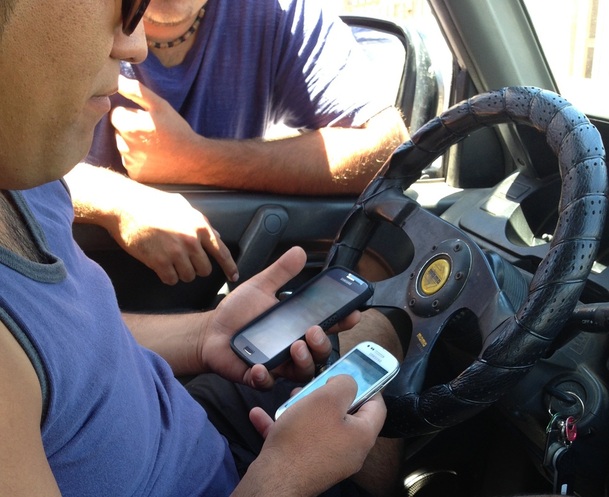For part one, click here: facebook: the facts
For part two, click here: whatsapp: the facts
For part three, click here: twitter: the facts
Perhaps in part because of the former popularity of Fotolog, Instagram is well used in Alto Hospicio, with 22% of survey respondents saying they used the app. particularly by teens and those in their 20s. In my survey of social networking users, Instagram was used by 35% of teens, 26% of 20-somethings, 21% of 30-somethings. No one over 40 on the survey reported using the application.
While Fotolog was a site aimed at uploading digital pictures and allowing the poster to add a caption and friends to “like” or comment on photos. Instagram is similar, but requires a smartphone or tablet that works on an application operating system, in order to upload photos. Instagram crops the photos into squares and allows users to choose “filters” which change the contrast, color tone, saturation, and focus of the photos. What results is often something that looks like an over- or under-exposed polaroid picture. For many users worldwide, this is the appeal of Instagram—turning the ordinary into the beautiful. Yet most users in Alto Hospicio seem content with portraying the ordinary.
Teen users often post several pictures a day, usually of mundane items like new gym shoes, breakfast, their freshly washed car, “selfies” while at school, and photo collages made with another app. Older users in their 30s tend to have more artistic subjects to their photos: the beach, the hands of a large group of people toasting at a bar, flowers, lone trees against a sunset, or somewhat artistically composed portraits of friends (often in black and white). Often they post these photos both on Instagram and on Facebook. As the reverse of Twitter for Instagram, for many users Instagram serves as an add-on to Facebook, allowing them to enhance the photos they post there, rather than serving as a photo posting site in it’s own rite.
This artistic usage of Instagram is well-known even to those who usually post photos of less “artistic” subjects. Having followed a few of the Red Foxes Offroading Club members on Instagram, I was used to them primarily posting pictures of their vehicles, but their explanation of the application differed from their usage. I had been invited to an asado [cook out] at one of their homes on a lazy Sunday afternoon. When I arrived everyone was looking at Jhony’s new Samsung tablet phone. Though Jhony, at 29 years old, was one of the youngest members of the group, he admittedly was the least technology-literate. “I need Facebook and WhatsApp, but I don’t know what else.” He said to the group of 7 men. Answers were shouted from all directions: Shazam, Skype, Google Chrome, Youtube, and Instagram. “What’s Instagram for?” asked Jhony. Alex explained “You upload pictures and the whole world says ‘I like it!” “Oh, so it’s good for my self-esteem?” Asked Jhony. Alex agreed, sarcastically adding “Yep, it makes you feel like a real photographer.” Paul agreed, adding “It's for ugly people like us. You take pictures and we come out looking good. It works like magic.” Their comments were obviously satirizing the way other people use the application, rather than reflecting their own use, but they still appreciate that Instagram might make their photos of tire tracks in the sand just a little more aesthetically pleasing.
Aside from the option of aesthetically enhancing photos with Instagram, it’s most important aspects are those related to interacting with other users. Like Fotolog followers can like or comment on a friend’s photo. And like Twitter within captions and comments people can “mention” other users or “hashtag” terms for searching. The hashtag functions is often used, especially by younger Instagrammers, to solicit more followers and likes. Sometimes this is explicit, as in when they use terms such as #instalike #instafollow #like4like or #follow4follow. These essentially suggest to others that if they like the picture or start to follow them, the user will reciprocate by liking photos or following their account as well. Other hashtags are used with the same goal in mind, but with less explicit deal-making. #InstaChile #Iquique #Altohospicio #Galaxy4s are all commonly used tags, as well as those describing what appears in the photo such as #lunch #mountain #beach #child or #shoes.
Most Instagram users leave their account open so that anyone can see their pictures or follow them. In conjunction with the use of hashtags, this allows for a much wider audience than family and friends in Alto Hospicio interacting with these users. As many people mentioned to me throughout surveys, Facebook is primarily for communicating with family, friends from school or work, neighbors, and other people with whom you have or have had a relationship face to face. Twitter and Instagram take as a base these face to face friends, but supplement it with as many strangers as possible. Though most usually end up being within Chile, and a few in other parts of South America, there is still a sense that Instagrams and Tweets are being broadcast to a wider world. This is more true of younger users who utilize hashtags for search purposes, than those in their 30s who primarly use it as a way to beautiful photos that are bound for Facebook.

 RSS Feed
RSS Feed
